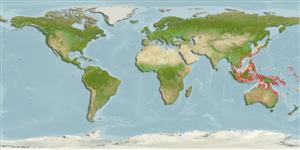>
Tetraodontiformes (Puffers and filefishes) >
Monacanthidae (Filefishes)
Etymology: excelsus: Name meaning 'elevated', referring to it prominently elevated dorsal and ventral profiles..
Environment: milieu / climate zone / depth range / distribution range
Ecología
marino asociado a arrecife; rango de profundidad 8 - 25 m (Ref. 90102). Tropical
Western Pacific: northern Australia to southern Japan.
Length at first maturity / Tamaño / Peso / Age
Maturity: Lm ?, range 2 - ? cm
Max length : 2.5 cm TL macho / no sexado; (Ref. 2334)
Short description
Morfología | Morfometría
Espinas dorsales (total): 2; Radios blandos dorsales (total): 22-24; Radios blandos anales: 20 - 22; Vértebra: 20. Diagnosis: Extremely small size at maturity (1.5 cm SL). Prominently elevated dorsal and ventral profiles. Extremely long bristles on caudal peduncle of male, projecting posteriorly to behind middle of caudal fin. Low fin ray counts (D.22 to 24; A.20 to 22; P.10) (Ref. 35708).
Inhabits sheltered coastal habitats, usually in areas with mixed low reef and sparse seagrass (Ref. 48637).
Life cycle and mating behavior
Madurez | Reproducción | Puesta | Huevos | Fecundidad | Larva
Randall, J.E., G.R. Allen and R.C. Steene, 1990. Fishes of the Great Barrier Reef and Coral Sea. University of Hawaii Press, Honolulu, Hawaii. 506 p. (Ref. 2334)
IUCN Red List Status (Ref. 130435)
Threat to humans
Harmless
Human uses
Más información
Age/SizeCrecimientoLength-weightLength-lengthLength-frequenciesMorfometríaMorfologíaLarvaDinámica larvariaReclutamientoAbundanciaBRUVS
ReferenciasAcuiculturaPerfil de acuiculturaRazasGenéticaElectrophoresesheritabilidadEnfermedadesProcesamientoNutrientsMass conversion
ColaboradoresImágenesStamps, Coins Misc.SonidosCiguateraVelocidadTipo de nataciónSuperficie branquialOtolitosCerebrosVisión
Herramientas
Special reports
Download XML
Fuentes de Internet
Estimates based on models
Preferred temperature (Ref.
123201): 25.2 - 29.3, mean 28.6 °C (based on 1897 cells).
Phylogenetic diversity index (Ref.
82804): PD
50 = 0.6250 [Uniqueness, from 0.5 = low to 2.0 = high].
Bayesian length-weight: a=0.01995 (0.00943 - 0.04220), b=2.93 (2.75 - 3.11), in cm total length, based on LWR estimates for this (Sub)family-body shape (Ref.
93245).
Nivel trófico (Ref.
69278): 3.0 ±0.4 se; based on size and trophs of closest relatives
Resiliencia (Ref.
120179): Alto, población duplicada en un tiempo mínimo inferior a 15 meses (Preliminary K or Fecundity.).
Fishing Vulnerability (Ref.
59153): Low vulnerability (10 of 100).
